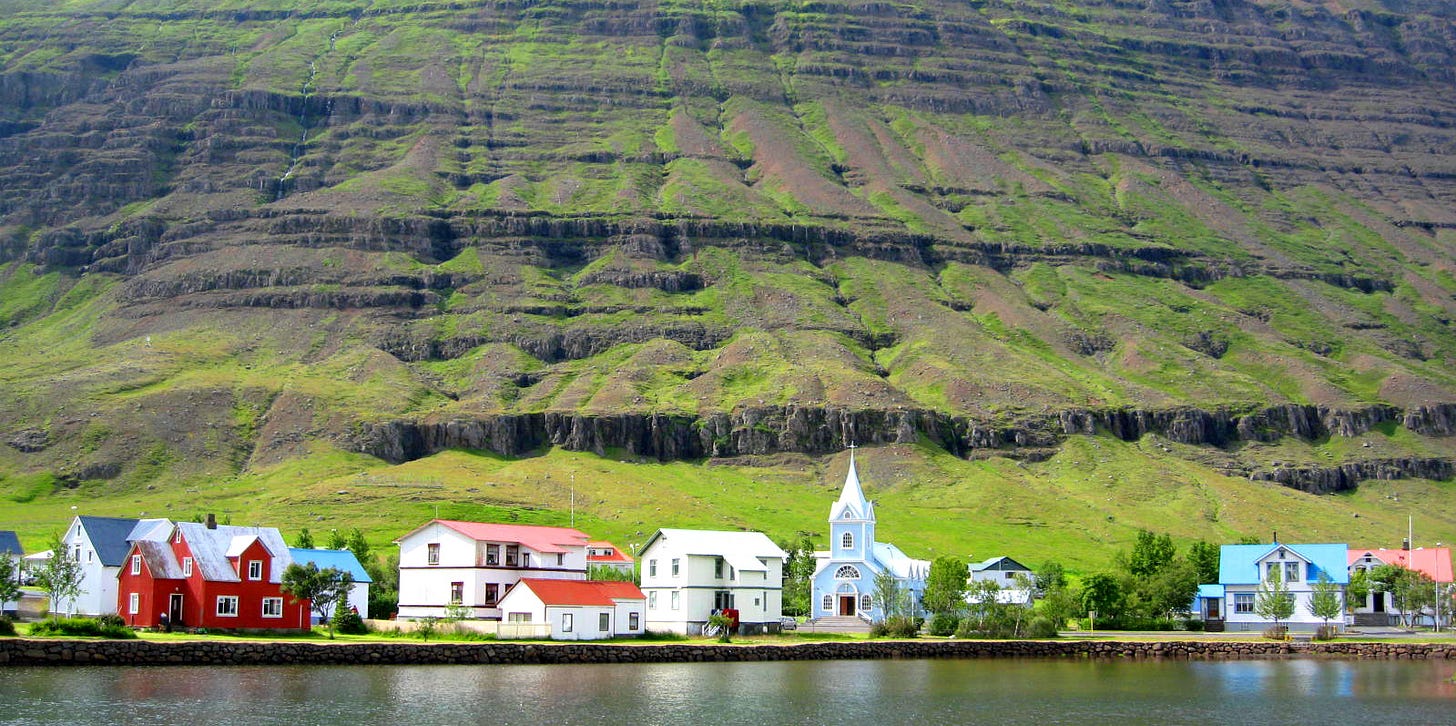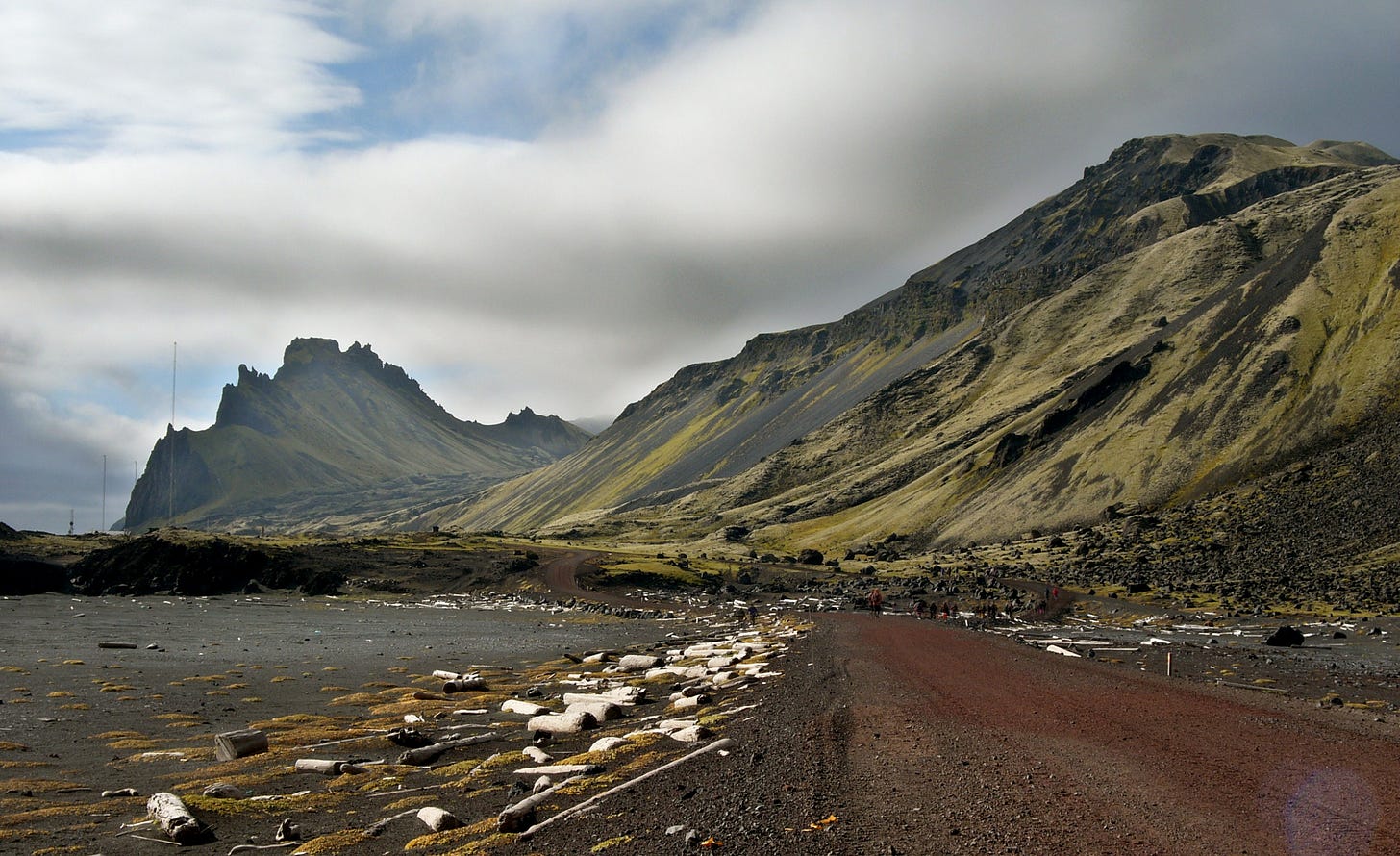The east of Iceland is, by most people’s standards, a remote place. And yet it is far from cut off from the rest of the Europe.
The town of Seyðisfjörður, named after one of the many fjords which define the twisting coastline in these parts, began life as a trading hub for foreign fishermen and whalers. Its Norwegian-style wooden buildings bring an array of incongruous brights to the mottled greens and browns of the sub-arctic landscape.
It was here that the first telegraph cable connecting Iceland with the rest of the world — via the Faroe Islands and Shetland — was brought ashore in 1906. And today the M/S Norröna, Iceland’s only international car ferry, links the town with the northern tip of Jutland via weekly sailings, at least in the brighter months of the year.

Of course, the sea itself has always delivered glimpses of far-off lands to Iceland’s shores.
Excavations of an eleventh-century church at Þórarinsstaðir, a fifteen-minute drive along the fjord from Seyðisfjörður, found that larch and pine were used in the construction of the floor in the nave and choir, as well for the coffins in the adjacent graveyard.1 What makes this interesting? Well, larch and pine are not native to Iceland — the North Atlantic is not known for its trees — but instead wash up on the country’s beaches as driftwood from the boreal forests of Northern Russia.2
Fallen trees start their journey towards Iceland on the great rivers of Siberia — the Yenisei, the Ob, the Lena — which eventually sweep them out into the Arctic Ocean. From there, they travel westwards on ocean currents among drifting sea ice, before reaching the warmer waters of the North Atlantic, where they are released from their frozen conveyers and driven onto treeless isles.
In the absence of any serious home-grown timber, whoever built the wooden church at Þórarinsstaðir looked to shore for the latest arrivals from the east — materials at once exotic and familiar, and befitting the new religion now gradually bedding in.

Archaeological excavations all across the North Atlantic reveal that driftwood has long run through daily life in the region. Throughout Scotland’s isles, exotic conifer woods turn up in Viking settlements, Pictish brochs, Iron Age huts and even Neolithic villages — all thought to have arrived as driftwood from the eastern seaboard of America.3 Whereas driftwood today may be most associated with quaint gift-shop trinkets in seaside towns, for coastal communities of the past it was the stuff of life — a plentiful raw material from which homes could be built, warm fires fuelled, and everyday tools fashioned.
Gift shops aside, the modern world — in its search for pathways towards a more sustainable, circular economy — appears to be rediscovering the potential of driftwood. All that time spent on the waves, it turns out, gives the wood some unique properties; an accident of nature that could be harnessed for specialist technologies and applications, from cutting-edge green architecture to biomass energy.4
The race is very much on to explore all the possibilities, especially given that the future of North Atlantic driftwood is far from certain. A recent study suggested that, with the predicted loss of Arctic sea ice to come, Iceland’s driftwood supply could come to an end by the year 2060.5
It would be a sad end to the story of the exotic woods which have long shaped life across the North Atlantic.
Steinunn Kristjánsdóttir, Simona Lazzeri & Nicola Macchioni, An Icelandic medieval stave church made of drift timber: the implications of the wood identification. Journal of Cultural Heritage 2, 2001, 97−107.
Ólafur Eggertsson, Origin of the driftwood on the coasts of Iceland: A dendrochronological study. Jökull 43, 1993, 15-32.
J.H. Dickson, North American driftwood, especially Picea (spruce), from archaeological sites in the Hebrides and Northern Isles of Scotland. Review of Palaeobotany and Palynology 73, 1992, 49-56.
Daniel Chuchala, Anna Sandak, Kazimierz A. Orlowski, Jakub Sandak, Ólafur Eggertsson & Michal Landowski. Characterisation of Arctic driftwood as a naturally modified material. Part 1: Machinability. Coatings 11(278), 2021, 1-13.
Tomáš Kolář, Michal Rybníček, Ólafur Eggertsson, Alexander Kirdyanov, Tomáš Čejka, Petr Čermák, Tomáš Žid, Hanuš Vavrčík & Ulf Büntgen, Predicted sea-ice loss will terminate Iceland's driftwood supply by 2060 CE. Global and Planetary Change 213, 2022, 1-8.



Just before the pandemic I went the Viking Museum in Roskilde, Denmark, which is a living museum that shows the shipbuilding process from the tree onward. Was really interesting to see it.
And we really don't think about how tree species shape our world, from landscaping to furniture. So thanks for this.
Very interesting. I had never thought about this before!